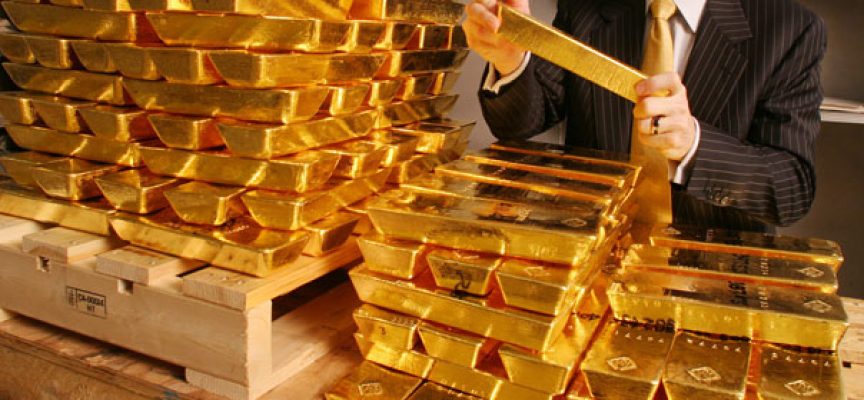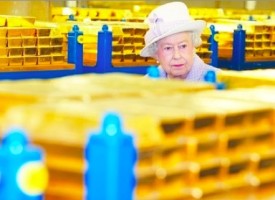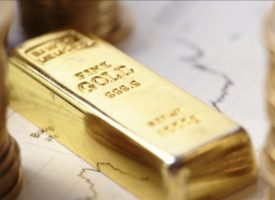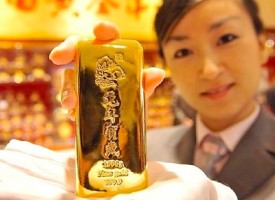Today the man who is connected in China at the highest levels said the price of gold is set to reverse higher, will surge $450.
Inflation is Back
October 7 (King World News) – John Ing: We believe America’s government-supported recovery is at risk with their debt skyrocketing to 110 percent of GDP, in part because the government finances are stretched after spending a mammoth 15 percent of GDP to prevent the pandemic crisis from becoming a financial crisis, according to recent IMF data. Meantime, government spending, thanks to the pandemic rose 34 percent with the government financing or monetizing that debt and there is no credible plan to get out of this debt trap. Never in history has there been so much money spent in so short a time, dwarfing the money spent after the last global financial crisis in 2008.
A look back at history shows that rising inflation can easily morph into hyperinflation. Lessons can be learned from the way hyperinflation developed in Germany, Austria, Hungary or Venezuela today. The common denominators?
* Reckless fiscal policy
* Deficit spending as each country ran enormous budget deficit financed by themselves.
* Double digit then triple digit increases in money supply.
* Government financed debt.
The United States has ticked off all the boxes. Money supply has grown 33 percent over a two- year period. The Fed has bought and monetized almost half of the public offerings in circuitous fashion. Although, US inflation at 5.4 percent is nowhere near hyperinflation levels, US producer prices increased solidly in August for the biggest gain in 11 years, suggesting that inflation will persist. In fact, the bubble-prone Fed is happy that inflation has exceeded their own targets believing that the uptick is transitory and will return to the Fed’s 2 percent target. Yet, they shouldn’t be celebrating too soon.
Greenflation: Greening the Economy Will be Inflationary
The shin bone is connected to the knee bone, connected to the … so goes the song “Dem Bones”. That song also describes the UK energy crisis where the shortage of carbon dioxide and a confluence of factors are ironically contributing to a food, gas, and labour crisis leading to higher inflation. Also inflationary is the global push to lower carbon emissions and adoption of “cleaner” sources of energy that has hampered commodity production, pushing up prices for everything from natural gas, aluminum and food, exacerbated by Brexit shortages. We can’t lower emissions and subsidize fossil at the same time, without a cost.
The UK government is scrambling because of rocketing wholesale natural gas prices due to low storage facilities that squeezed supplies, driving up electricity prices, leaving consumers facing massive home heating bills and a dozen bankrupt energy wholesalers. As a result, heavy users like the large fertilizer plants were forced to close. The fertilizer plants make ammonium nitrate from natural gas and the halt in production of fertilizer resulted in a shortage of carbon dioxide which is a by-product, used to stun animals before slaughter and in hospitals for minor surgeries. The CO2 shortage has put meat suppliers out of business and the high energy prices have even affected steel plants. the subsidisation of the market resulted in government borrowings in August reaching the second highest ever.
Ironically energy inflation led by the soaring price of natural gas has become a global phenomenon leading to supply shocks and increased demand in India, China, and Europe. The spike in the cost of natural gas is particularly inconvenient for governments trying to decarbonize their economies (coal, oil and natural gas still makes up 80 percent of our global energy mix) and it did not help that Britain phased out most of its coal-fired power stations. Like the Seventies, everything is interconnected, the shin bone is connected….
Insiders just invested another $56 Million in this 12 million ounce
Canadian gold company! TO FIND OUT WHICH ONE
CLICK HERE OR ON THE IMAGE BELOW.
Greenflation’s Unintended Consequences
Our interconnected world is heading into a global energy crunch and a bleak winter, which will reinforce inflation’s upward push. According to the IEA, 81 precent of the world’s energy supply still comes from fossil fuels. Coal, carbon and European gas prices hit record highs as crude oil surged beyond $80 a barrel or the first time in 7 years. German inflation is at 29-year highs. Less drilling, government-imposed cutbacks on emissions and the global pandemic bounce resulted in a rebound in demand at a time when the industry is trying to replenish low supplies. Natural gas has increased five-fold. China too is grappling with a power shortage because much if its electricity is generated using coal that could damage the broader economy. COVID-19 continues to ravage supply chains, driving up shipping costs and prices.
During the past decade, Europe shutdown hundreds of coal plants to curb energy consumption and carbon emissions. Meantime, governments have spent trillions in handouts to renewable industries like wind and solar power, yet renewable energy has not replaced the shutdown in capacity, resulting in the shortages and high prices today. In addition, a pick-up in demand post pandemic also pushed up prices. Coal itself has tripled in price. And, to combat climate change, Europe’s cap-and-trade initiative pushed prices higher as the price of credits spiked because of the threat of government-imposed carbon taxes. The “greenflation” factors are reshaping the energy sector from a cyclical to a structural bull market.
A Recipe for Higher Inflation
The energy shortages in China also mirrored tight supplies in Europe as the economy post- pandemic caused a surge in energy consumption, exacerbated by reduced supplies due to the “green” industrial revolution. About 70 percent of China’s electricity generation is based on coal and the government’s edict have led to shortages, that were not replaced by renewables. China is facing power shortages due to its toughened regulations, which has resulted in shortages of coal supplies pushing energy prices higher causing the government to order energy companies to secure winter supplies “at all costs”. The power crunch also forced the rationing of electricity, affecting over 20 provinces as the country had to shutdown key downstream sectors, such as steel, aluminum and cement. Cheap energy has become part of the past. China’s energy problems have triggered a surge in food and agriculture prices as shutdowns and difficult harvests boost demand for corn, soy, wheat and cotton.
Italy has spent $1 billion in handouts to reduce consumer gas prices because more than two-thirds of their energy needs are imported. Italy has unveiled plans for a multibillion package because of fears of an energy squeeze after gas prices soared in Europe. The inflationary increase is being felt across the board as Europe faces a shortage due in part to lower storage capacity and tighter supplies from Russia, ahead of the start-up of the controversial NordStream 2 pipeline that bypasses the Ukraine. Soaring global energy prices are not transitory and the OECD expects that higher energy and wages prices will put upward pressure on prices for the next two years.
As a consequence, the International Energy Agency (IEA) has urged Russia to increase supplies to Europe beyond contractual amounts to alleviate the energy crisis. The irony is that all the world is coming together in Scotland for the UN Climate Summit at COP 26, pledging to reduce emissions by shutting down hydrocarbon energy, yet these same countries are subsidizing the usage. Climate change will be very costly…
ALERT:
Legendary investors are buying share of a company very few people know about. To find out which company CLICK HERE OR ON THE IMAGE BELOW.
 Sponsored
Sponsored
An End to Cheap Money?
Meantime the Fed’s excess liquidity continues to stoke the inflationary fires with the Fed continuing to buy $80 billion of Treasuries and $40 billion of mortgage-backed securities every month, adding to the gargantuan $8.3 trillion balance sheet, equivalent to almost half of the US economy. The Fed has spent the last decade combining monetary and fiscal policy using what was once experimental, quantitative easing to finance the government’s profligacy, ignoring the consequences of the resultant asset bubbles. That largesse of government flooded the market with newly created cash paid with a digital “click”, which has propped up stock prices through dividends and share buybacks. However, since future rates are likely to be higher than lower, as short rates inevitably move up, the interest bill will rise significantly, possibly quadrupling the current $500 billion interest bill – that is America’s Achilles heel.
When the Fed purchases Treasuries, it pays with money created by itself. Fuelled by the Fed’s ultra-loose monetary policy, this tsunami of cheap money has gone into the stock market, banks’ balance sheet, crypto and even helped finance that new Bronco or Corvette. Asset owners have also benefitted from cheap capital. Investors seem not too concerned. The Dow Jones is 20 percent above pre-pandemic levels. The technology driven Nasdaq is up almost 12 precent. Too much money chased too few goods.
Yet, the inflation outlook is ugly with pandemic related shortages for computer chips to coal supposed to be resolved by now. Instead, manufacturers are caught in broken supply chains, broadening out inflation. The rising cost of commodities also poses problems for the manufacturers who are also struggling with scarce labour, logistical problems and even the semiconductor shortages pushed up inflation. Although inflation has easily exceeded the Fed’s target, the Fed’s continuing purchases has caused the financial markets to overheat, stirring up trouble. No wonder we have the biggest asset bubble in US history.
Déjà vu
While the Fed is not yet ready to cut back on the trillions of dollars of monetary stimulus, the Fed has expanded what was once a temporary facility, the overnight Reverse Repurchase (RRPs) facility for overnight surpluses. The Repo facility was a swap arrangement designed for the Fed to offer Treasuries overnight in exchange for cash and the deal is reversed the next day, paying nominal rates of interest. However, for the money market player, the income though low was a money earner and, safe. Consequently, in the past month, the Repo facility had more than $1.6 trillion parked overnight, doubling the current participation to 70 institutions. Simply after 13 years of easy money, the Fed has “institutionalized” risk, making permanent its role. We believe that the Fed’s financial plumbing is clogging up, never a good sign.
All this points to the recent talk of an ‘exit strategy” or normalisation, which has investors rightly worried. Why? In 2015, rates went up and the market swooned. In the first quarter of this year, the 10-year Treasury yield rose by 80 basis points, reaching 1.74 percent and the market tanked. Today 10-year yields are up from 1.30 percent to 1.51 percent and “tapering” rhetoric alone has spooked the market giving rise to the shock the Fed is trying to avoid. Inflation and interest rates tend to move together. Today there is upward pressure on both as investors dump bonds on tightening fears. Yet, the Fed continues to purchase the same level of monthly asset purchases ($120 billion) as at the height of the COVID-19 outbreak a year and half ago. Worse, the Fed’s silence on rising inflation and the excesses in asset markets is breeding complacency similar to what happened in the Seventies. Déjà vu…
New interview from legend Doug Casey discussing gold, silver and
global chaos! To listen click here or on the image below.

Risk and Rewards in China
On China, Mr. Biden has escalated the Cold War despite the interdependence of our economies. Rather than rejoin the Trans Pacific Partnership, Mr. Biden created a submarine defense pact with the UK and Australia to counter China’s navy, which is now the world’s largest. While the US risks decoupling from its largest trading partner, Australia will have submarines.
And now, after three decades of firing up the capitalist engine and focussing on an export-led government, Beijing is pulling its economic interests away from America as Washington takes an increasingly hawkish stance towards China. The rapid growth of an industrialized China has created global iconic corporate behemoths but it appears that China has downshifted growth as part of a change in priorities. The world’s second largest economy has launched a volley of regulation changes, reigning in the big behemoths, overhauling technology, education, healthcare and housing sectors. The harsh intervention is an effort to make China a fairer and more productive country, and make its national champions toe the government line. China even hopes to inject greater discipline with stricter rules on borrowing, deleveraging the economy.
Left unsaid is that one of the main reasons for the government’s Calvinistic crackdown is a move to close the “wealth gap” which has widened during the pandemic by using some of those capitalist profits to boost social justice. Unlike the West, the Chinese view capitalism and profits as a means to end, rather than the goal itself. Also, the regulatory clampdown is a tool used to boost competition and reduce systemic risk. Despite being a major participant in the market economy. China is also seeking to boost self-reliance in natural resources, technology and finance.
Regulatory Crackdown, an Opportunity?
For example, the $120 billion private education business was brought down a peg to equalise educational opportunities in the wake of runaway growth in private schools. China’s tech giants must now allow government access to precious data, leveling the playing field. Small and innovative companies have been given room to grow. The toughened regulatory action on finance forced some of the state-owned corporate giants to repatriate funds. In order to avoid an Archegos or Lehman moment, the government has been tackling the high levels of consumer and corporate debt as part of its changing priorities imposing “three red lines” to curb excessive leverage.
Evergrande and Huarong, two giants that together owe half a trillion dollars were once part of the central engine of China’s economy, now risks default on their obligations. China’s pivot is also part of a social initiative to relieve the cost of living, and make the rich pay. Some have obliged with Chinese tech giants Alibaba and Tencent pledging to spend tens of billions for economic, job creation and social welfare by 2025 in support of Beijing’s new social contract, aka “spread the wealth”.
As a side note, the policies initially appear draconian, especially when viewed through Western lens. However, Western governments too are pursuing the fat cat banking sector, big data and drug behemoths, which are in the crosshairs of policymakers. The Biden government wants the rich to pay too for his $3.5 trillion of social spending, but the culture wars have increased the cost and partisan politics will likely stall his ambitious plans…
ALERT:
Billionaire and mining legend Ross Beaty, Chairman of Pan American Silver, just spoke about what he expects to see in the gold and silver markets and also shared one of his top stock picks in the mining sector CLICK HERE OR ON THE IMAGE BELOW TO HEAR BEATY’S INTERVIEW.

On the other hand, China has also ambitiously addressed one of the world’s most vulnerable sector, real estate. The world has enjoyed a housing boom fueled by historically low global interest rates. In China, housing makes up three-quarters of household wealth and about 29 percent of GDP. However, the world’s most indebted real estate player, Evergrande with over $300 billion of liabilities has been in trouble for years, which allowed officials to orchestrate an orderly restructuring. And rather than kick the can down the road and face the consequence of too much debt, China instead forced developers to take the hit with its tycoons taking on the role of bad guys.
Yet complicating China’s image is that despite these reforms, China remains one of the fastest growing countries with its growing middle-class, exceeding that of America. Today, China represents about one third of global GDP growth and almost half of global investment. China has a dominating grip on global commodity markets and the biggest trading partner of most countries. Europe and Asia have deep economic ties to China, both as an export market and supplier. The UK government is the exception as London and Beijing trade barbs over Hong Kong and infrastructure investment.
While western governments believe China has reverted back to anti-capitalist, it continues to steadily develop its capital markets, opening up its financial markets with an intent of developing its large retail dominated market into a more integrated model with the Stock Connect schemes linking China and Hong Kong or Shanghai and London markets. As part of its “common prosperity” goals, China’s plans a new Beijing stock exchange (BSE) to support the funding of small and medium sized businesses as a complement to the Shanghai Stock Exchange, STAR market and ChiNext, a Nasdaq-like subsidiary of the Shenzhen Stock Exchange. Almost 87 percent of employment is in private companies. In developing its onshore capital markets, China hopes to lessen its dependence on Wall Street.
In Debt We Trust
The most worrying aspect about the rivalry between China and the United States is that like China, the United States is inordinately dependant on debt. But no one here seems to care about the inexorably rising debt levels. Like China, the US economy was boosted by a debt-fueled property market as the pandemic, home buying and consumption binge put Americans deeply into debt. Investors seemed to go from deal to risky deal looking for places to park their cash because benchmark interest rates are near zero. This surge in public and private debt to record levels during the recovery and the recent building of inflationary pressures raises question whether the greatest monetary loosening can be unwound without doing great harm to the economy.
To be sure, the seeds of the next financial crisis have been planted. Complacency has become endemic. Today, investors who purchase US debt trust that the liability is backed by the “full faith and credit” of the United States and that they will honour their obligations. However, amid this complacency, the debt ceiling discussions which are a result of America’s penchant to finance themselves with debt, has become like every other issue overly politicized, ritualized and subject to whomever is in power. The trust deficit with America seems to be growing by the day. The longer Congress fiddles holding the market and dollar as hostage, the more challenging for an agreement. The stakes are high. America’s credit rating was downgraded in 2011 amid a previous debt ceiling impasse and the last one actually stopped government from working. Despite a sorry record of raising the debt ceiling some 78 times since 1960, the US is playing with fire, just to make political points…
To find out which silver company just made a major acquisition that will
quadruple their production click here or on the image below

Debt Ceiling Cracking
Although extended to December, the United States will run out of money because the debt ceiling breach prohibits new borrowing above the existing $28.5 trillion debt level. The Democrats’ current razor-thin majority in both Houses is not enough to end the stalemate because some of Biden’s own Democrats are balking at passing Biden’s ambitious $3.5 trillion social spending package, which not only violated the debt limit but passed without one Republican voting for the budget. In a game of chicken, the Republicans have also threatened to block a debt ceiling increase. As the impasse widens, the US will have to address the debt itself and that is a tall order for the co-authors of that debt so polarized.
… Mr. Biden’s popularity is sinking amid an ambitious social spending spree such that there are doubts over the direction he is taking the country. America keeps hollowing out its democracy at home, chipping away its credibility and with their patchwork health system, the debt showdown and fears of yet another dysfunctional government on Capital Hill, investors are concerned that a “game of chicken” could precipitate a global crash, unthinkable a year earlier. It has happened before. The last time the US defaulted on its debt was when Richard Nixon took the dollar off the gold standard in 1971. Gold was roughly US$35 an ounce then.
American Exceptionalism
… American exceptionalism has again been exposed by the pandemic, made worse by the unprecedented peacetime borrowings. We believe elements of American exceptionalism have eroded trust in government, undermined America’s international reputation and, ominously damaged America’s credit worthiness.
The greenback is America’s highest margin export. It is cheap to produce and is used by most of the world. This dependence on a fiat currency relies on the credit worthiness of that respective sovereign country. However, we believe its vulnerability is exposed by the unsound practices of the Federal Reserve or the European Central Bank or the Bank of England as they sink into the debt trap. The US has lost its reputation of financial integrity because the economy is so dependent on asset inflation.
However, we think this financially engineered growth is vulnerable, particularly if the central bankers were to “normalise” rates to say 5 percent needed to stamp out 5 percent inflation, a level which would cause a house of cards collapse. Currently cryptocurrencies are touted as an alternative to money. It is not, crypto is an asset but it is not fungible in our day to day lives. Gold however is money. It is used by central banks as reserves and collateral and helped some people escape the Holocaust and recently, Afghanistan.
Dethroning the Greenback
From the stock market to property to credit, the string of bubbles has expanded in scope and risk. History shows that the bubble-prone US economy is a breeding ground for risk, aided by Wall Street’s financial engineering prowess. In 1987, the bubble was portfolio insurance strategy which did not protect investors from losses. In 1994, Wall Street designed interest rate swaps, which imploded. In 2000 the dot-com bubble burst cutting stock prices in half. And in 2007, derivatives of mass destruction caused havoc and a near depression. The bad news is that we haven’t learned from the past and bubbles are everywhere. New realities heighten the risk of unintended consequences…
With surface samples as high as a staggering 300,000
grams of silver, this company is looking to make
one of the largest silver discoveries in history!
CLICK HERE OR IMAGE BELOW TO FIND OUT MORE.

If the US Congress fails to raise the debt ceiling, sparking a “technical” default, the unintended chain reaction in the bond and derivative portfolios of investors will leave devaluation of the dollar as the one remaining option. Inflation is our next big problem. Monetary and fiscal policies to date have underweighted inflation but policies to “green” our economies and achieve net zero will in our view unleash and exacerbate the inflation forces. For now, American privilege remains exorbitant, but a substantially lower dollar is in the offing.
Of significance, is that the Cold War with China could also have long reaching consequences, particularly since China not only has been a big buyer of American government debt but also one of the largest holders of a treasury debt. However, recent figures show that China has been absent as a buyer over the last five months. Instead, China has been buying gold as an alternative to the dollar. China is the world’s gold producer and largest consumer. China’s gold reserves at 1,948 tonnes makes it the sixth largest holder after the US, Germany, Italy, France and Russia. China is also the largest importer of gold and its steady accumulation is believed to have topped the 8,143 tonnes of reserves held by the US government. Gold, in our opinion will a good thing to have.
What ballasts the US monetary system is debt and its weight is growing. The question is who will finance America’s debt if the Chinese decide to invest in gold or Japanese yen or sterling? Who will finance Mr. Biden’s spending spree? If the Chinese won’t step up to the plate, maybe the Fed could create another trillion or two with another “click” or mint a trillion dollar coin? While a rising tide lifts all boat and amid a market that records daily highs, everyone seems to be enjoying the liquidity but there are numerous signs than the liquid market is becoming illiquid.
History shows that the consequences of higher inflation is higher interest rates, an outcome even more likely due to the deterioration of US government finances. Persistent growth in money and credit in the 1970s saw the price of goods and services go up to double digit levels – so did rates to stop inflation. Today, such growth has seen the prices of financial assets go up, and up. Today it is called a bull market. Another outcome of higher inflation though is much higher gold prices. While gold has lost seven percent this year and the broad markets post daily highs, inflation is rising. Gold is set to rise, it is a classic hedge against inflation. As such we continue to believe that gold will hit $2,200 as an interim target.
***ALSO JUST RELEASED: It “Will Be Devastating,” Another Day, Another Parabola In Commodities, Gold, Silver, Epic Short Squeeze CLICK HERE.
***ALSO JUST RELEASED: Celente – The Situation Is About To Get Much Worse In The United States CLICK HERE.
***ALSO JUST RELEASED: SPROTT: The Gold Market Is Poised To Regain Its Strength, Plus This Is The Harsh Reality The US Is Facing CLICK HERE.
***To listen to exactly what levels to watch in the gold and silver markets and much more in this important audio interview CLICK HERE OR ON THE IMAGE BELOW.
***To listen to this powerful audio interview with Alasdair Macleod CLICK HERE OR ON THE IMAGE BELOW.
© 2021 by King World News®. All Rights Reserved. This material may not be published, broadcast, rewritten, or redistributed. However, linking directly to the articles is permitted and encouraged.










